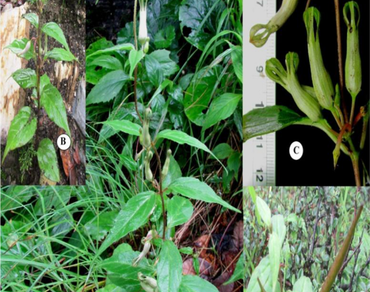Ceropegia hookeri C.B. Clarke ex Hook.f. (Apocynaceae: Asclepiadoideae), an Endangered species new record for the flora of Western Himalaya, India
Research Articles | Published: 10 July, 2022
First Page: 688
Last Page: 693
Views: 3427
Keywords: Ceropegia hookeri , Endangered, New record, Western Himalaya, Uttarakhand, India
Abstract
Ceropegia hookeri C.B. Clarke ex Hook.f. is being reported for the first time from the Western Himalaya. This contribution marks rediscovery of this taxon after a gap of nearly 140 years. Present collection of this species from Munsyari block of Eastern Uttarakhand (India) also marks its westernmost range of its global distribution. Detailed morphological features of aerial and underground parts are given to aid field identification. Based on IUCN Red List criteria, we suggest that this species be assigned the status of Endangered (EN) category. Further, surveys of populations from Nepal and Tibet would be required to confirm this status. The study presented first ever record on the western-most distribution of Ceropegia hookeri, a species rare in occurrence. The information given in this paper may provide opportunities for conserving the species in its natural habitats through appropriate management interventions and hence, it may be useful not only for the floristics but also from the aspects of conservation.

References
Albers F, Meve U (2002) Illustrated handbook of succulent plants: Asclepiadaceae. Springer, Berlin, pp 63–108
Ansari MY (1984) Asclepiadaceae: Genus-Ceropegia. Fascicles of Flora of India, Fasc. 16. Botanical Survey of India, Howrah, p 35
Bruyns PV (1995) Notes on Ceropegia of the Cape Provinse. Bradleya 3:7–11
Bruyns PV (2014) The Apocynaceae of Namibia. Strelitzia 34. South African National Biodiversity Institute, Pretoria, pp 1–158
Forman L, Bridson D (1992) The herbarium handbook. Royal Botanic Gardens, Kew
Hooker JD (1883) The Flora of British India, vol 4. Reeve & Co., London, p 73
Huber H (1957) Revision der Gattung Ceropegia. Memórias de Sociedade Broteriana, vol 12. Instituto Botanicoda Universidade de Coimbra, Coimbra
Jagtap AP, Singh NP (1999) Fascicles of Flora of India, Asclepiadaceae and Periplocaceae. Kolkata, Fascicle-24. Botanical Survey of India, Howrah
Kambale SS, Yadav SR (2019) Taxonomic revision of Ceropegia (Apocynaceae: Ceropegieae) in India. Rheedea 29(1):01–115. https://doi.org/10.22244/rheedea.2019.29.1.01
Karthikeyan S, Sanjappa M, Moorthy S (2009) Flowering plants of India. Dicotyledons (Acanthaceae-Avicenniaceae), vol 1. Botanical Survey of India, Calcutta, pp 160–164
Kishor K (2015) Plant diversity and carbon storage potential of high altitude forests in Munsyari region of Kumaun Himalaya. Ph.D. thesis submitted to Kumaun University, Nainital, India
Kumar R, Sharma S, Dwivedi MD (2018) Ceropegia mizoramensis and C. murlensis (Asclepiadaceae), two new species from Northeast India with phylogenetic and morphological evidence support. Taiwania 63:163–170. https://doi.org/10.6165/tai.2018.63.163
Li PT, Gilbert MG, Stevens WD (1995) Asclepiadaceae. In: Wu ZY, Raven PH (eds) Flora of China, vol 16. Science Press, Beijing and Missouri Botanical Garden Press, St. Louis, pp 189–270
Meve U (2009) Ceropegia thailandica (Asclepiadoideae-Ceropegieae), a spectacular new Thai species. Bradleya 27:161–164. https://doi.org/10.25223/brad.n27.2009.a3
Meve U. (2002) Ceropegia. In: Albers F, Meve U editors. Illustrated handbook of succulent plants: Asclepiadaceae. Springer, Berlin.
Nautiyal DC, Sharma SK, Pandit MK (2009) Notes on the taxonomic history, rediscovery and conservation status of two endangered species of Ceropegia (asclepiadaceae) from Sikkim Himalaya. J Bot Res Insti Texas 3(2):815–822
Nayar MP, Sastry AR (1987–1989) Red Data Book of Indian plants, vols. I–III. Botanical Survey of India, Calcutta
Pangtey YPS, Samant SS, Rawat GS (1988) Contribution to the flora of Pithoragarh district, Kumaun Himalaya. Himalayan Res Dev 7:24–46
Rao RR, Sharma BD (1990) A manual for herbarium collections. BSI, Calcutta
Rawat GS (1984) Studies on the high altitude flowering plants of the Kumaun Himalaya. Ph.D. thesis submitted to Kumaun University, Nainital, India
Samant SS (1987) Flora of the Central and South Eastern Parts of the Pithoragarh District. Ph.D. thesis submitted to Kumaun University, Nainital, India
Sri Rama Murthy K, Kondamudi R, Reddy MC, Karuppusamy S, Pullaiah T (2012) Check-list and conservation strategies of the genus Ceropegia in India. Int J Biodiv Conserv 4(8):304–315. https://doi.org/10.5897/IJBC12.011
Surveswaran S, Kamble MY, Yadav SR, Mei S (2009) Molecular phylogeny of Ceropegia (Asclepiadoideae, Apocynaceae) from Indian Western Ghats. Plant Syst Evol 281(1–4):51–63. https://doi.org/10.1007/s00606-009-0182-8
Swarupanandan K, Mangaly JK (1992) A new species of Ceropegia (Asclepiadaceae) from India. Nord J Bot 12(6):699–701. https://doi.org/10.1111/j.1756-1051.1992.tb01851.x
Uniyal BP, Sharma JR, Choudhery U, Singh DK (2007) Flowering Plants of Uttarakhand (A Checklist). Bishen Singh Mahendra Pal Singh, Dehradun
Vogel EFD (1987) Manual of herbarium taxonomy: theory and practice. Rijks Herbarium, Leiden
Author Information
Deaprtment of Botany, D.S.B. Campus Kumaun University, Nainital, India